Having a clear understanding of the average cost of a trip to Ireland is key when planning your trip. So, I’ll cut to the chase!
The average trip to Ireland cost, based on a 1 week trip in June for 2 people flying from the USA, is:
- Budget: €4,387/$4,624 (€2,194/$2,312 p/p)
- Mid-range: €6,741/$7,120 (€3,371/$3,560 p/p)
- Luxury: €26,397/$27,879 (€13,199/$13,940 p/p)
Why you can trust this guide: With 35 years in Ireland and a decade spent helping thousands plan their visit to Ireland on every budget, I’m well-versed in all the ins and outs of Ireland trip costings.
How much is a trip to Ireland costing these days?
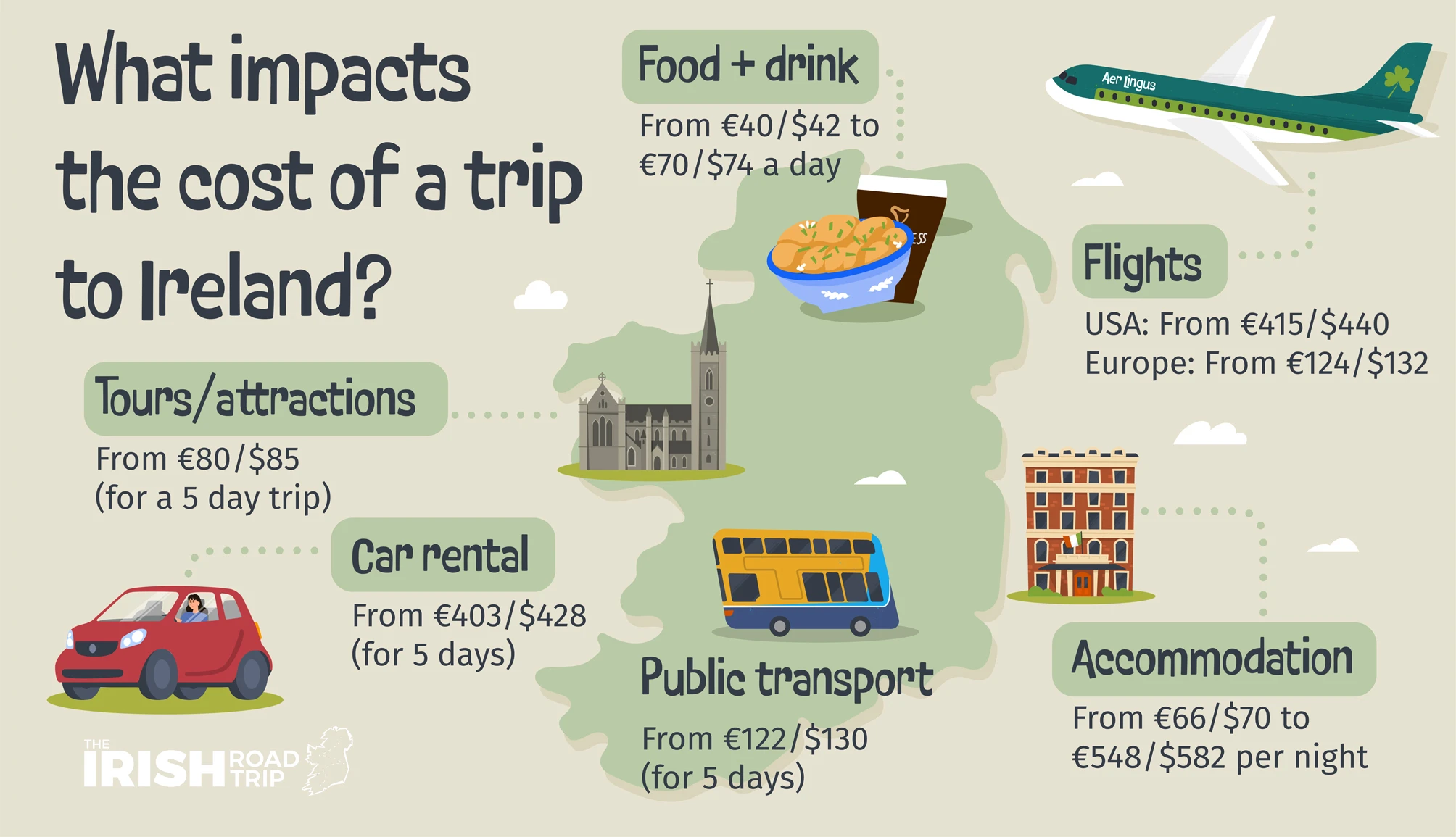
The cost of a trip to Ireland can vary widely depending on whether you’re traveling on a low, medium, or high budget.
To help you plan, I’ll break down costs for each budget level, with prices based on June 2025.
Cost of a trip to Ireland for 2 people for 1 week

Here’s a breakdown of the estimated cost to go to Ireland for a week for two people traveling from NYC, based on prices for June 2025.
This includes flights, accommodation, meals, and typical daily expenses (the workings are in this document):
Budget trip for 2 people:
- Flights from JFK: €1,548/$1,634
- Public transport: €202/$213
- Accommodation: €1,015/$1070
- Food: €80/$84 per day
- Drinks: None
- Tours/attractions: €190/$200
- Travel Insurance: €300/$316
TOTAL: The cost of a trip to Ireland for 2 people for 1 week on a budget is €4,387/$4,624 with a 15% buffer (€2,194/$2,312 p/p)
Mid-range trip for 2 people:
- Flights from JFK: €1,974/$2,080
- Economy rental car: €265/$280
- Rental car insurance: €128/$135
- Fuel: €172/$182.32
- Tolls: €17/$18.02
- Accommodation: €1,778/$1,875
- Food: €120/$128 per day
- Drinks: €164/$173
- Tours: €224/$236
- Travel Insurance: €300/$316
TOTAL: The cost of a trip to Ireland for 2 people for 1 week on a medium budget is €6,741/$7,120 with a 15% buffer (€3,371/$3,560 p/p).
Luxury trip for 2 people:
- Flights from JFK: €16,376/$17,280
- Large rental car: €415/$438
- Rental car insurance: €71/$75
- Fuel: €256/$270
- Tolls: Allow €17/$18
- Accommodation: €2,926/$3,108
- Food: €235/$248 per day
- Drinks: €480/$506
- Tours: €468/$496
- Travel Insurance: €300/$316
TOTAL: The cost of a luxury trip to Ireland for 2 people for 1 week is €26,397/$27,879 with a 15% buffer (€13,199/$13,940 p/p).
Ireland trip cost for 1 person visiting for 1 week

Here’s an estimated cost breakdown for one person spending 7 days in Ireland and travelling from NYC in June 2025.
This covers flights, accommodation, meals, and standard daily expenses:
Budget trip for 1 person:
- Flights from JFK: €774/$817
- Public transport: €101/$106.50
- Accommodation: €507.50/$535
- Food: €40/$42 per day
- Drinks: None
- Tours/attractions: €95/$100
- Travel Insurance: €150/$158
TOTAL: The cost of a trip to Ireland for 1 person on a budget visiting for 1 week is €2,194/$2,312 with a 15% buffer.
Mid-range trip for 1 person:
- Flights from JFK: €987/$1,040
- Economy rental car: €265/$280
- Rental car insurance: €128/$135
- Fuel: €172/$182.32
- Tolls: €17/$18.02
- Accommodation: €1,778/$1,875
- Food: €60/$64 per day
- Drinks: €82/$87
- Tours: €112/$118
- Travel Insurance: €150/$158
TOTAL: The cost of a trip to Ireland for 1 person on a medium budget visiting for 1 week is €4,728/$4,993 with a 15% buffer.
Luxury trip for 1 person:
- Flights from JFK: €8,188/$8,640
- Large rental car: €415/$438
- Rental car insurance: €71/$75
- Fuel: €256/$270
- Tolls: Allow €17/$18
- Accommodation: €1,463/$1,554
- Food: €118/$124 per day
- Drinks: €240/$253
- Tours: €234 / $248
- Travel Insurance: €150/$158
TOTAL: The cost of a luxury trip to Ireland for 1 person for 1 week is €13,639/$14,400 with a 15% buffer.
The different factors that affect the cost of an Ireland vacation

There are several factors to consider when trying to determine how much for a trip to Ireland.
Take 20 seconds to read the points below as they’ll get you up-to-speed quickly:
1. You can spend anywhere from €89/$95 to €150/$159 per day
There really is no average cost of a trip to Ireland – every trip and every traveller is different. For example, some of our younger readers might be happy to stay in a hostel while some of our older readers won’t.Some people prefer to take organised tours while others like to rent a car and go it alone. All of this impacts your Ireland trip cost massively.
2. You’ll have avoidable and unavoidable costs
Flights, accommodation and food are all unavoidable costs. Now, the cost of each can go up and down depending on 1, the time of year you visit and 2, whether you choose budget, mid-level or luxury options. Some avoidable costs are the likes of drinks in pubs, souvenirs and car rental.
3. What you spend ultimately comes down to you
As is the case with any country, you can do Ireland on a budget if you need to. You just need to be careful when planning your trip to Ireland to make sure you stick within the budget you have to play with.
4. Always add a safety buffer
Below, you’ll find a breakdown of how much you can expect to spend in Ireland. However, please note that it’s always worth adding a buffer of 10-15% to your overall budget just to be safe. Unexpected costs will always arise.
1. Flight costs
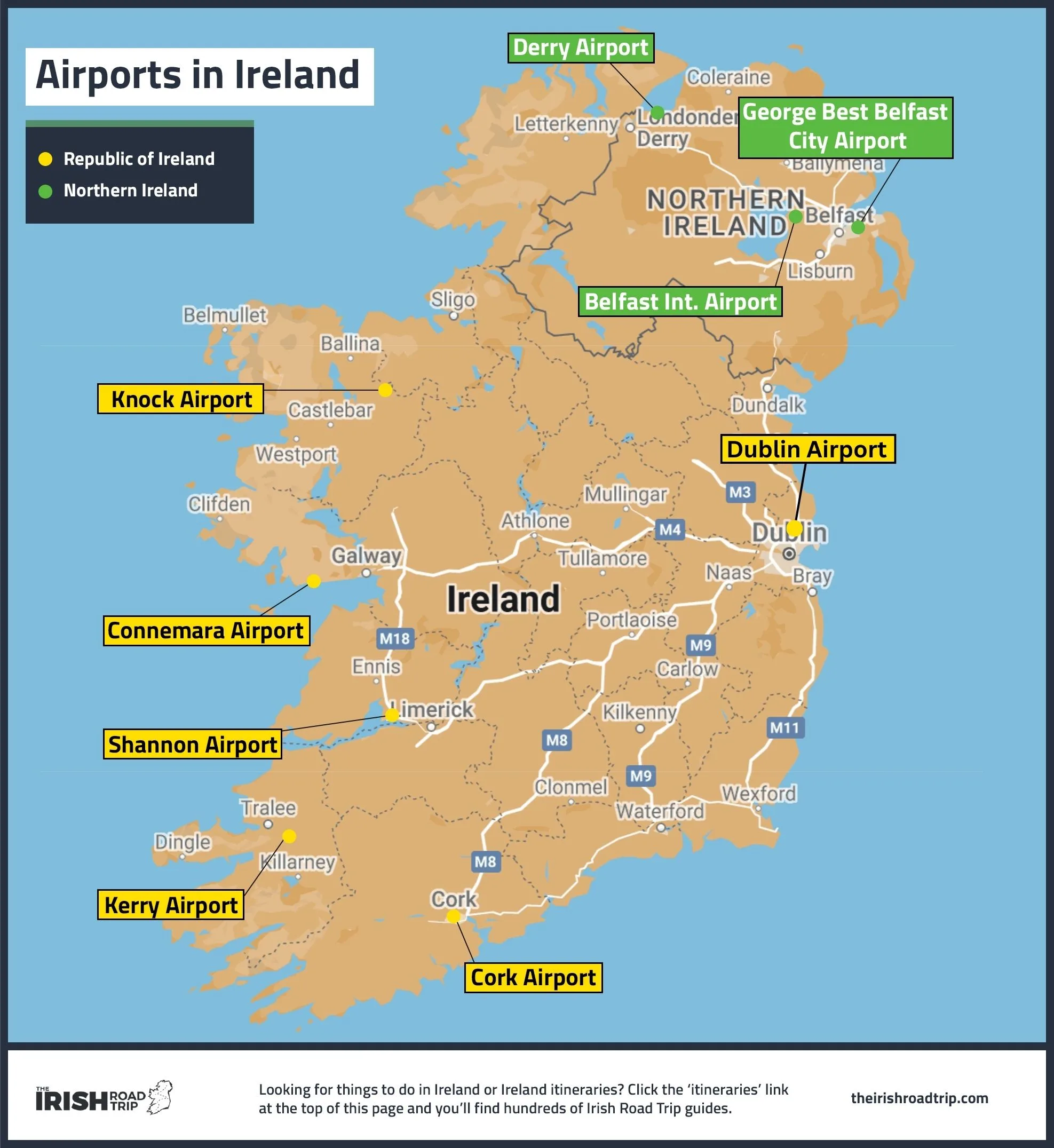
Click to enlarge
The first thing to consider when coming up with an average cost of a trip to Ireland is the price of flying into one of the airports in Ireland.
The cost of flights will vary depending departure location, time of year, baggage. The examples below use the cheapest direct flights.
Example 1: Flying from NYC
- December: From €458/$484
- March: From €437/$461
- June: From €774/$817
Example 2: Flying from Frankfurt
- December: From €203/$214
- March: From €104/$110
- June: From €127/$145
2. Accommodation costs

Your choice of accommodation can have a massive impact on the overall cost of your trip to Ireland. For this section, I’ll be looking at accommodation prices in Dublin.
I’ll use a Friday night and the price will be based on two people sharing. Please note that prices are likely to change – you can browse the latest prices here:
1. Budget
- December: From €93/$99 per night
- March: From €115/$122 per night
- June: From €145/$154 per night
2. Mid-range
- December: From €183/$194 per night
- March: From €178/$189 per night
- June: From €199/$211 per night
3. Luxury
- December: From €301/$319 per night
- March: From €350/$371 per night
- June: From €400/$424 per night
3. Food and drink
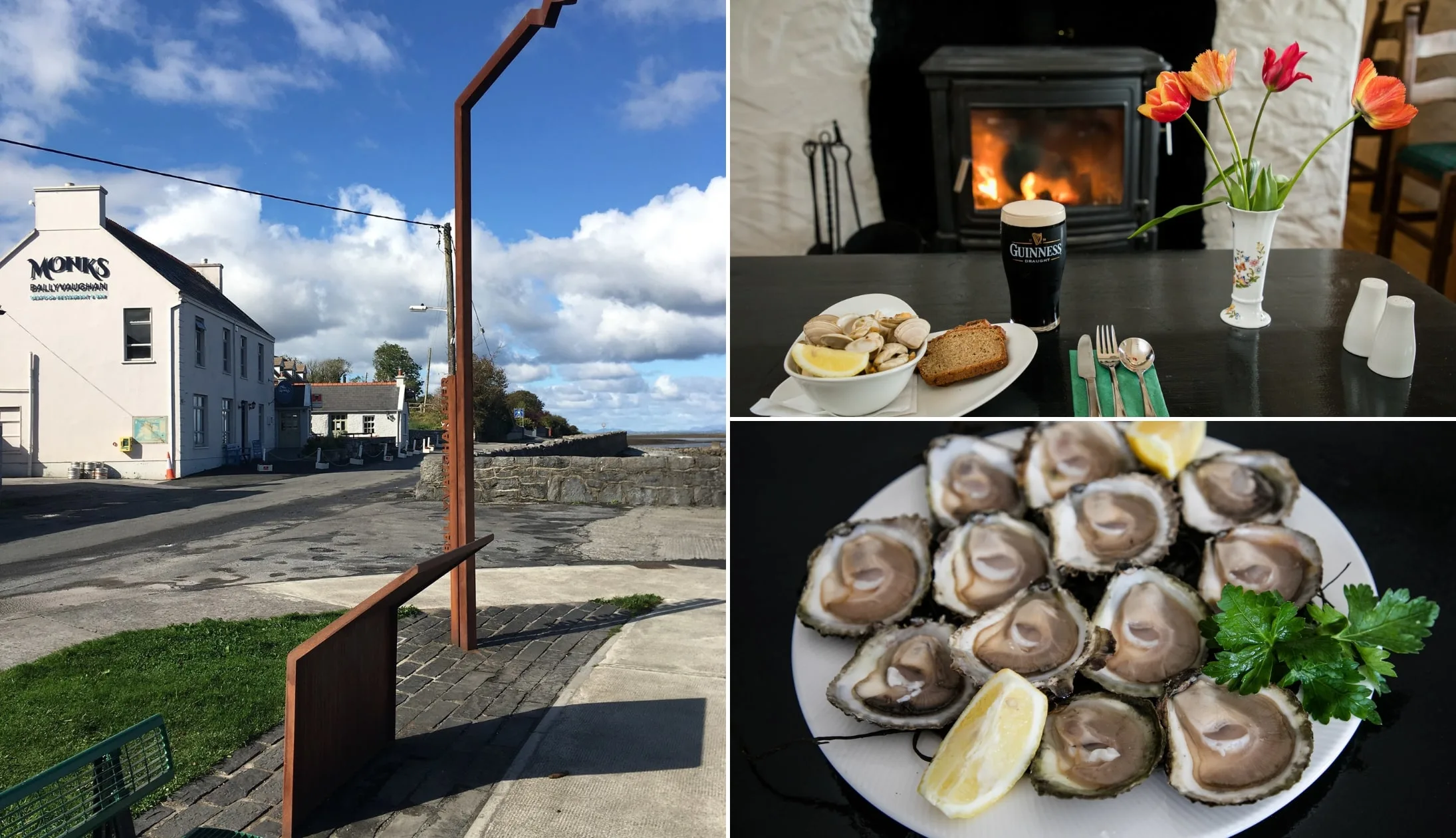
Photos via Monk’s on FB
The cost of food and drink is another unavoidable element that can have an enormous impact on the cost for a trip to Ireland.
Location plays a role. For example, the price of a pint of Guinness in rural Donegal will be considerably cheaper than Dublin City.
The type of establishment also has a big impact (e.g. having lunch in a cafe vs a restaurant). Here are some sample costs based on Dublin prices:
1. Breakfast: €14/$14.84 to €18/$19.08
If you have breakfast included in your accommodation, happy days.
If not, you can expect to pay between €14/$14.84 to €18 $19.08 in a pub or cafe.
2. Lunch: €15/$15.90 to €20/$21.20
Lunch (e.g. soup and a sandwich or an Irish stew) can cost between €15/$15.90 to €20/$21.20. If you’re looking to keep your Ireland trip cost down, buy items to make a packed lunch in a shop/store.
3. Dinner: €20/$21.20 to €40/$42.40
The cost of dinner varies hugely. If you opt for pub grub or a mid-range restaurant, allow between €20/$21.20 to €40/$42.40 for a drink and a main course. If you’re opting for higher-end restaurants, allow €60/$63.28 to €100/$105.46 p/p.
4. Drinks: €5.77/$6.08 to €8/$8.49
Drinking every night can see the cost of a trip of Ireland skyrocket. In Dublin, you’ll now pay a minimum of €5.77/$6.08 for a Guinness, €8/$8.44 for a glass of wine and €8/$8.44 for a low-end whiskey.
4. How you’ll get around
There are several different ways of getting around Ireland (from rental car to private group tours) and they vary a fair bit in terms of price.
How you get around will not only effect the cost of a trip to Ireland but it’ll have a profound effect on your overall experience. Here’s an overview:
1. Rental car
Renting a car in Ireland can be costly but it gives you a lot of flexibility. There are a number of costs to consider with a rental and driving in Ireland in general.
Below, you’ll find prices for a 5-day trip in April 2025. The prices are for an economy car that seats four and that has an automatic transmission (note: prices may change so see latest rental costs here):
- Cost of the rental: €121/$128.26
- Insurance: €52/$55.12
- Fuel: €172/$182.32 (€171.52c per litre for a 1,000 km trip)
- Tolls: Allow €17/$18.02
2. Buses
Buses tend to come in two forms – the ones that operate within a county, e.g. Galway, and ones that travel between counties. Here are some price examples:
- The Dublin Leap Visitor Card: Get unlimited travel in Dublin. 3 days costs €16/$16.87
- Dublin Bus Fares: From €1.50/$1.59 to €3/$3.17
- Dublin to Galway: €27/$28.55 (return)
3. Trains
If you’re exploring Ireland without a car, the chances are you’ll take a train or three. Here are some sample prices:
- Dublin to Belfast: From €32/$33.83
- Dublin to Cork: From €69/$72.95
- Dublin to Galway: From €33/$34.89
4. Organised tours
Organised tour prices vary massively. We have seen several 5-day tours for this year that cost in the region of €1,155/$1,227.
This includes your transport, 5 nights in high end hotels, numerous paid attractions, 3 dinners and 1 lunch. You’ll need to add in your flights, other meals, any drinks and tips.
5. Tourist attractions
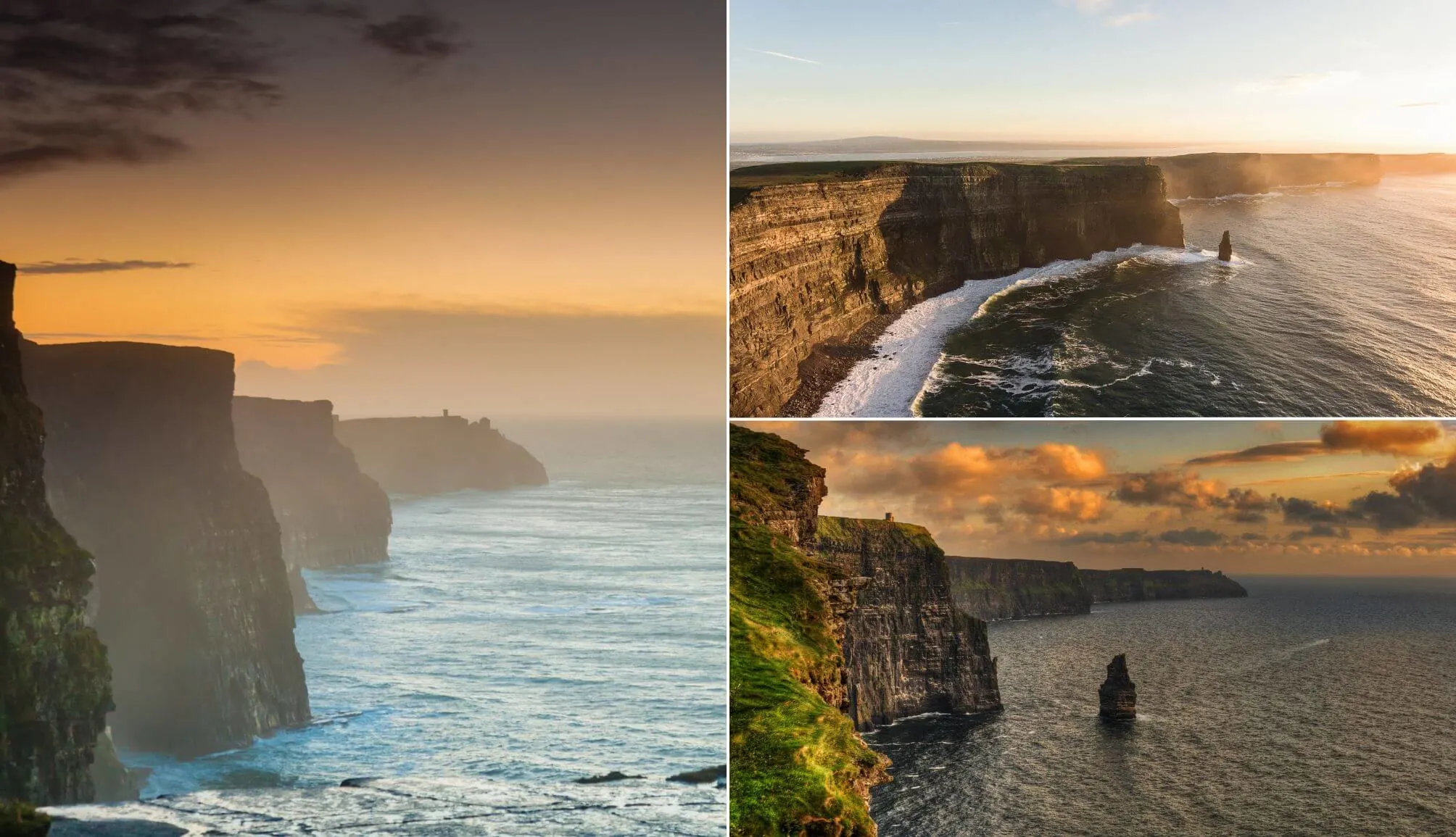
Photos via Shutterstock
There’s plenty of things to do in Ireland and, while there are endless places that are free to visit, other attractions will have an admission fee.
This varies quite a lot depending on the attraction. But, to give you a rough idea of what to expect, we’ll go over some of the more popular places below.
1. State owned attractions
Some of the most popular attractions in Ireland are run by the state and, in general, prices tend to be reasonable.
The likes of Dublin Castle, the Rock of Cashel and Kilmainham Gaol are all good value at €8/$8.43 for an adult ticket.
2. Privately owned attractions
There are a number of other privately owned attractions that are well worth a visit on your trip to Ireland. Tickets for these tend to be more expensive.
An adult ticket for Kylemore Abbey, for example, costs €17/$17.92 while admission to the Guinness Storehouse costs €28/$29.52.
3. Organised full and 1/2 day tours
You can find countless organised day trips throughout Ireland. They typically offer a comfortable coach journey that takes in a clatter of attractions before dropping you back where you started.
For example, you could be staying in Dublin and you take a day trip to the Cliffs of Moher or the Causeway Coast. Expect to pay from €75/$79.07 for these tours (browse prices here).
6. Travel insurance

Photos via Shutterstock
The second last variable in your trip to Ireland cost is travel insurance.
There are any number of things that can cause you to cancel your trip altogether, but it’s also worth covering yourself for any issues that might happen while you’re away.
A decent travel insurance policy will give you peace of mind and ensure that should the worst happen, you’ll be protected.
For shorter trips, you can easily find travel insurance for less than €20/$21.08 (covering two people), with an excess of around €100/$105.42 to €150/$158.14.
Annual cover typically starts at around €30/$31.63 but can cost more than €100/$105.42 depending on the level of cover and the amount of excess you’re willing to pay.
7. Souvenirs

Now, if you’re trying to cut the cost of your Ireland vacation cost, avoid souvenirs altogether.
However, if you want to bring a bit of Ireland home with you, here are some examples using Carroll’s Irish Gift prices:
- Claddagh ring: From €26/$27.41
- Magnets: From €5/$5.27
- Aran jumper: From €55/$57.98
FAQs
I get my fair share of emails asking how much does a trip to Ireland cost based on a never-ending number of factors.
In the section below, I’ve stuck in the most FAQs based on the data above.
Is Ireland expensive to visit?
Yes, but costs vary widely depending on how you like to travel. For a 7 day trip in June 2025 for two people from the USA, you can expect: Budget: €4,387/$4,624, Mid-range: €6,741/$7,120, and Luxury: €26,397/$27,879.
How much is a trip to Ireland for 2 weeks?
The average cost to go to Ireland for 2 weeks for two people on a medium budget, departing from the USA in June 2025, including a 15% buffer, is €10,226/$10,792 (€5,113/$5,396 per person).
How much is a trip to Ireland for 1 week?
The cost of a trip to Ireland for 2 people for 1 week on a medium budget is €6,741/$7,120 with a 15% buffer (€3,371/$3,560 p/p).


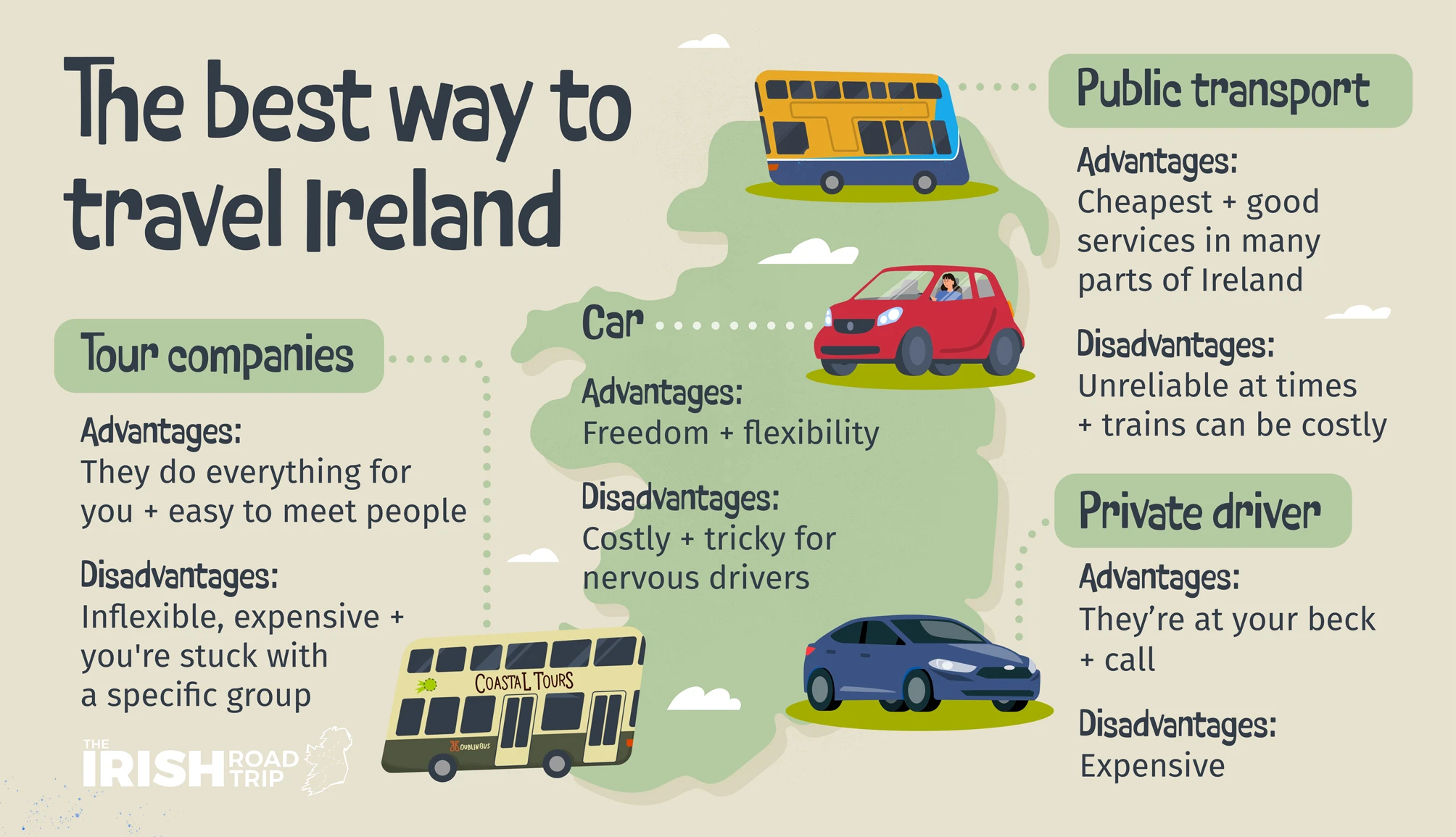
Kelly
Saturday 21st of January 2023
Hello Kieth, When was your Example A budget created? We are headed to Ireland May of 2023 and wondering how accurate those figures are. They look on the low side. Kelly
Keith O'Hara
Monday 23rd of January 2023
Hey Kelly - This was all done at the end of last year and I know Andy, one of our senior writers here, put a lot of time into the research of each of the workings. You can click into the google sheet that shows the calculations, also. Shout if there's anything you need!
Debra
Thursday 19th of January 2023
Do you have a 14 day recommendation that included N. Ireland. We are traveling end of August.
Keith O'Hara
Thursday 19th of January 2023
Hey Debra - if head into
this guideand scroll down to the itineraries starting from Belfast you'll find plenty of 14-day road trips to choose from!